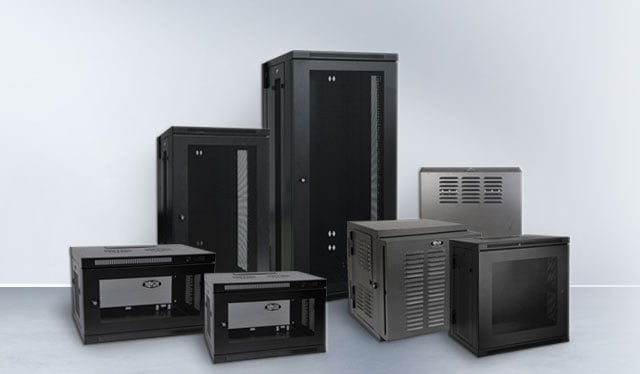
Now that we’ve entered the cloud hosting and storage revolution, more medium- to large-sized businesses are migrating their IT infrastructure and data to the cloud, therefore eliminating the need for large-scale network and storage equipment. The cloud phenomenon helps explain the downsizing of on-site data centers and the increase in the need for smaller network equipment, such as Wall Mount Rack Cabinets that are designed to save floor space in smaller server rooms and closets.
With a vast array of Wall Mount Rack Enclosures on the market, how do you know which one best suits your needs? Here are 4 quick tips to help you select the perfect rack for your specific application.
To determine the height of the Wall Mount Rack Cabinet you need, you need to add up the total height of your equipment. 1U (or Rack Unit) is equal to 1.75 inches, so a 10U cabinet will accommodate equipment with a total height of 17.5 inches. A 2U server would occupy two of the available 10 rack units. Be sure to make an accurate assessment of the amount of rack space you currently need, and allow for future growth.
Wall Mount Rack Cabinets feature adjustable mounting depths with minimums of either 3 or 17 inches and maximums of 16.5, 20.5 or 32.5 inches. To determine the maximum depth you need, measure the depth of your equipment and add 3 inches to allow space for cabling. A cabinet with a maximum depth of 20.5 inches will accommodate equipment with a maximum depth of 17.5 inches.
Wall Mount Racks have a weight limit. Make sure that the capacity of the rack is greater than the total weight of the equipment being mounted. Also check to make sure there are proper studs on the wall that can support the weight of the rack and housed equipment.
Most Wall Mount Rack Cabinets come with a variety of options and special features, such as perforated metal or plexiglass front doors depending on your airflow requirements, locking front doors for increased security, heavy duty rolling casters for easier installation, and hinged wall brackets that swing away from the wall for convenient access to equipment and cabling.

Eaton is an intelligent power management company dedicated to improving the quality of life and protecting the environment for people everywhere. We are guided by our commitment to do business right, to operate sustainably and to help our customers manage power—today and well into the future. By capitalizing on the global growth trends of electrification and digitalization, we’re accelerating the planet’s transition to renewable energy and helping to solve the world’s most urgent power management challenges.
With the acquisition of Tripp Lite, Eaton has transformed its distributed IT infrastructure and connectivity product portfolio. Eaton’s Tripp Lite series products provide convenient, reliable and cost‑efficient IT solutions that integrate seamlessly with Eaton’s industry-leading enterprise power management products and services.

QUICK LINKS
© Eaton. All Rights Reserved.